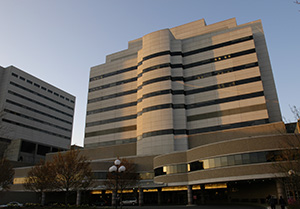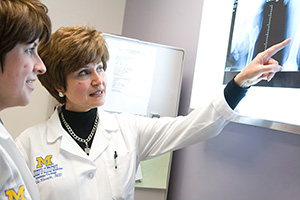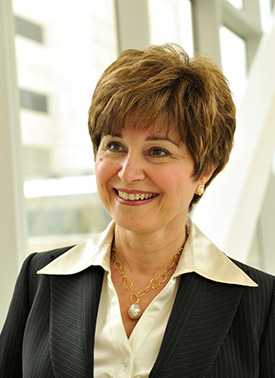April 2, 2015:
A conversation with Maha Hussain, MD, FACP, FASCO, associate director of clinical research at the University of Michigan Comprehensive Cancer Center, which is a member of the Big Ten Cancer Research Consortium.
Q: What kind of impact do you see the Big Ten Cancer Research Consortium having on cancer clinical trials?
Conquering cancer requires impactful research that is efficiently implemented and evaluated in clinical trials that are timely, appropriately designed, and skillfully performed and analyzed. This requires team effort.
Collaborating with other institutions allows for a broader and deeper brain trust while allowing the efficient testing of novel concepts and approaches in a more representative patient population. The synergist interactions, the collaboration, the implementation — all are aimed at one ultimate goal: Making a real difference for patients and their families.
Personalized therapeutics and precision medicine represent an exciting collection of opportunities for developing new therapies for advanced cancers. The challenge that we and others face is how best to successfully conduct trials targeted at specific sub-groups of patients to provide meaningful data that can inform randomized phase III trials. Working together to conduct smart clinical studies of targeted therapeutics is critical if we are to have an impact on the field. Leveraging the intellectual resources of the Big Ten institutions creates an opportunity to foster exciting new ideas and hopefully identify new ways to detect and treat cancer.
Q: What are some of the strengths that the UMCCC brings to the consortium?
The University of Michigan Comprehensive Cancer Center is consistently among the top 10 U.S. cancer centers for National Cancer Institute funding and our Medical School was recently ranked 12th in the country for total NIH funding. The bench to bedside interaction at our Cancer Center is a very dynamic, interactive, and rewarding process. As clinical researchers at the UMCCC, we are able to leverage the novel discoveries made in the laboratories of our colleagues and translate them into clinical trials for our patients. Similarly the feedback from the bedside to the bench is very active to meaningfully inform the research.
We’re also a very collaborative and deep center. The University of Michigan not only has a great Medical School, but also has top-rated schools of public health, engineering, dentistry, pharmacy, nursing, social work, and others. This makes us truly unique, with top 20 placements for so many graduate programs, and top-performing adult and children’s hospitals. Our faculty base is incredibly strong too: The university has 59 past and present members of the Institute of Medicine.
Recently, the university created a Department of Biomedical Engineering, with footholds in both the College of Engineering and the Medical School. The idea is to develop more technologies that improve health care, by linking the engineers who understand the technology with the doctors who understand how the technology can benefit patients. This is a fairly unique arrangement. One of the benefits at U-M is that these two schools are both top-ranked and are right across the road from one another.
 Our Cancer Center researchers are spread out among nine schools and 67 departments throughout the university, and we have teams collaborating in multidisciplinary ways to identify and understand the molecular pathways at work in cancer. This translates into drug discovery, biomarker identification, and novel imaging techniques to help us better assess a patient’s response to treatment.
Our Cancer Center researchers are spread out among nine schools and 67 departments throughout the university, and we have teams collaborating in multidisciplinary ways to identify and understand the molecular pathways at work in cancer. This translates into drug discovery, biomarker identification, and novel imaging techniques to help us better assess a patient’s response to treatment.
These collaborations allow us to take advantage of a variety of academic and scientific backgrounds and perspectives to develop and test novel approaches to detecting, imaging, and treating cancer. As I mentioned earlier, we are collaborative by nature, so working together with colleagues through the Big Ten Cancer Research Consortium is natural.
Q: What kind of scientific developments happening at the UMCCC are changing the way that we diagnose and treat cancer?
Our institution and teams are known for our strengths in basic and translational research. Our scientists work closely with experts in drug discovery and biomarker development to turn their findings into potential therapies for patients. We have a strong portfolio of phase I-II trials, testing potential new compounds. Our researchers have led many seminal clinical trials that have changed the standard of care and redefined how cancer is treated. We have some of the top experts on biomarker development and cancer imaging who are finding better ways to target treatment and assess response.
As an example, we have first-class expertise in molecular and genetic analyses that we have started implementing in clinical trials and for discovery purposes. Our MI-ONCOSEQ program is an incredible resource. It uses high-throughput gene sequencing techniques to help inform clinical trial decisions. We bring together our top experts in a precision medicine tumor board that includes clinical oncology, clinical genetics, genomic science, bioinformatics, clinical pathology, social and behavior sciences, and bioethics. It uses gene sequencing results to give clinicians and patients recommendations regarding clinical trials or targeted therapy based on the molecular characteristics of an individual patient’s cancer. Ours is one of the few pioneering efforts in this area and we hope to set the standards for the future when clinical sequencing becomes adopted as routine standard of care.
Another real strength is in outcomes research. We have researchers in virtually every cancer type looking at how physicians and patients make decisions about care, the impact of cancer treatment on employment and financial status, and inequities in care among geographic, racial, or socioeconomic groups. These issues are critical to ensuring that every cancer patient receives the best care available.
Q: How will being a part of the Big Ten CRC differ from other collaborative efforts of which your center has been a part?
 Conducting high quality clinical trials and research requires an interplay of science, medicine and business. The Big Ten CRC has a great potential for scientific synergy based on the depth of the member institutions. We’ve also structured through the consortium practical aspects for the inter-institutional interaction in a manner that allows efficient implementation of ideas. This combination provides a very fertile environment for the conduct of novel clinical trials focused on seminal scientific questions.
Conducting high quality clinical trials and research requires an interplay of science, medicine and business. The Big Ten CRC has a great potential for scientific synergy based on the depth of the member institutions. We’ve also structured through the consortium practical aspects for the inter-institutional interaction in a manner that allows efficient implementation of ideas. This combination provides a very fertile environment for the conduct of novel clinical trials focused on seminal scientific questions.
We all are active members in a variety of federal and/or foundation consortia. This consortium does not replace other collaborative initiatives; however it adds significant opportunities to foster new ideas and create more efficiencies in clinical trials to expedite potential new therapies through rigorous testing. By combining our collective brain trust, we can identify areas ripe for scientific collaboration and opportunities to take the research beyond what one of us alone could envision or accomplish. The consortium also allows us to pool our patient populations so we can test potential new therapies in people of very diverse backgrounds. By working together, we aim to find answers much sooner.
It has been 44 years since the “war on cancer” was declared. And while we haven’t yet cured cancer completely, we are witnessing reductions in mortality in patients diagnosed with many different cancer types in the United States. This is great news. But, there remains an unacceptable number of patients both in and outside the U.S. who must endure grueling treatments with no guarantee of success. Too many people still die from this disease. The reality is that we cannot afford to spend more time and be inefficient in pursuing the goal of curing or significantly reducing mortality and suffering from cancer. We need to do this soon, and make life better for our patients and their families. This collaboration is a win/win for everybody, and more importantly a win for our patients.
About the Big Ten Cancer Research Consortium: The Big Ten Cancer Research Consortium creates a unique team-research culture to drive science rapidly from ideas to treatment-changing paradigms. Within this innovative environment, today’s research leaders collaborate with and mentor the research leaders of tomorrow with the unified goal of improving the lives of all patients with cancer.
About the Big Ten Conference: The Big Ten Conference is an association of world-class universities whose member institutions share a common mission of research, graduate, professional, and undergraduate teaching and public service. Founded in 1896, the Big Ten has sustained a comprehensive set of shared practices and policies that enforce the priority of academics in student-athletes’ lives and emphasize the values of integrity, fairness, and competitiveness. The broad-based athletic programs of the 14 Big Ten institutions provide nearly $200 million in direct financial aid to almost 9,500 student-athletes for more than 11,000 participation opportunities on 350 teams in 42 different sports. The Big Ten sponsors 28 official conference sports, 14 for men and 14 for women, including the addition of men’s and women’s lacrosse as official sports for the 2014-15 academic year. For more information, visit www.bigten.org.

















Subscribe to the Big Ten CRC Newsletter X
X Facebook
Facebook YouTube
YouTube